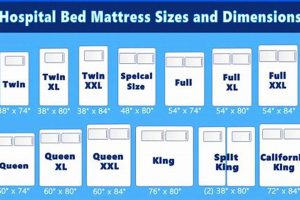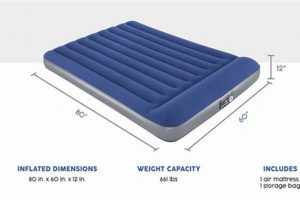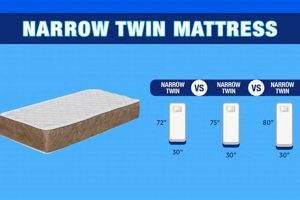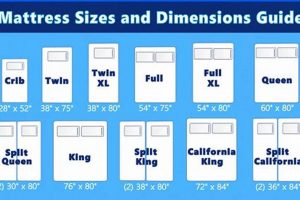Mattress sizing refers to the standardized measurements used to categorize bedding designed for sleeping. These measurements, typically expressed in inches or centimeters, dictate the compatibility of a mattress with various bed frames and bedroom layouts. For example, a ‘king’ measures approximately 76 inches wide by 80 inches long.
Understanding these measurements is crucial for selecting appropriate bedding and ensuring comfortable sleep. Standardized sizing simplifies the process of purchasing sheets, blankets, and other bedding accessories. Historically, variations in mattress measurements were more common, leading to difficulties in finding compatible bedding. Today’s standardized sizes provide convenience and consistency for consumers.
The following sections will provide a comprehensive overview of common mattress sizes, including their specific measurements and suitability for different individuals and room sizes. Details on non-standard sizes and custom options will also be explored.
Selecting the Correct Mattress Size
The selection of an appropriately sized mattress is paramount for ensuring sleep quality and optimizing bedroom space. Consider the following guidelines to facilitate an informed decision.
Tip 1: Assess Occupant Needs: Individual sleepers typically require a minimum of a twin XL, while couples generally benefit from a queen or king. The size should accommodate movement and prevent sleep disruption.
Tip 2: Measure Room Dimensions: Accurate room measurements are crucial. Ensure adequate space for movement around the bed after placement. Consider door swing and closet access.
Tip 3: Evaluate Frame Compatibility: The mattress should be compatible with the bed frame. Incorrect sizing can lead to instability and premature wear. Verify interior frame measurements before purchase.
Tip 4: Account for Sleeping Style: Individuals who move frequently during sleep may require a larger mattress. Consider a king-size mattress to accommodate restless sleepers.
Tip 5: Consider Future Needs: Anticipate potential changes in sleeping arrangements. Purchasing a larger mattress can accommodate future additions, such as children or pets.
Tip 6: Factor in Height: Taller individuals require a longer mattress, such as a Twin XL or a California King, to ensure adequate legroom and prevent discomfort.
Tip 7: Explore Custom Options: Non-standard sizes are available for unique requirements. Consult with a mattress manufacturer to explore custom dimensions for specialized bed frames or room configurations.
Selecting the correct mattress size involves considering individual needs, room dimensions, and frame compatibility. Adherence to these guidelines ensures optimal sleep quality and efficient space utilization.
The subsequent sections will delve into specific mattress size classifications and their respective applications.
1. Length
The length of a mattress, a critical element of its overall dimensions, directly impacts the comfort and suitability for the user. Insufficient length can lead to discomfort, disrupted sleep, and potential orthopedic issues due to inadequate support for the legs and feet. For instance, an individual of six feet in height requires a mattress length exceeding 72 inches to avoid postural strain. Standard mattress lengths vary, with Twin mattresses typically at 75 inches, while Twin XL and Queen mattresses extend to 80 inches, and King and California King options reach 80 and 84 inches respectively. Choosing a mattress with sufficient length is paramount for ensuring proper spinal alignment and preventing sleep disturbances.
The practical significance of understanding mattress length extends beyond individual comfort. Commercial applications, such as in dormitories or hospitals, require careful consideration of patient or resident heights to select appropriately sized mattresses. Overlooking length requirements in such settings can negatively impact patient recovery and resident well-being. Furthermore, custom mattress manufacturers provide options for individuals with unique height requirements, allowing for the creation of mattresses that precisely accommodate their specific needs. This demonstrates the importance of length as a customizable parameter within the broader context of mattress dimensions.
In summary, the length of a mattress is a fundamental dimensional characteristic that significantly influences sleep quality and physical well-being. Selecting a mattress with adequate length is essential for ensuring proper support and avoiding discomfort. While standard sizes cater to a wide range of individuals, custom options exist for those with specific needs, highlighting the adaptability and importance of length within the overall concept of mattress dimensions.
2. Width
Mattress width, a fundamental aspect of overall mattress dimensions, directly influences sleep comfort, partner accommodation, and space utilization. Precise width measurements are critical for ensuring adequate personal space and compatibility with bed frames and bedroom layouts.
- Individual Sleeper Space
Width determines the amount of personal space available to a sleeper. Insufficient width can lead to restricted movement and discomfort, especially for individuals who tend to toss and turn. For example, a Twin-size mattress, typically around 38 inches wide, may be inadequate for an adult, while a Queen-size, approximately 60 inches wide, offers more comfortable space for a single sleeper or a couple with limited room.
- Partner Accommodation
Width is a primary consideration for couples sharing a bed. A wider mattress, such as a King (76 inches wide) or California King (72 inches wide), provides more individual sleeping space, reducing the likelihood of sleep disturbance due to partner movement. Conversely, a Full-size mattress (54 inches wide) may prove too narrow for two adults, leading to compromised sleep quality.
- Room Size and Layout
Mattress width must be carefully considered in relation to room dimensions. A larger mattress may dominate a small bedroom, hindering movement and creating a cramped atmosphere. Accurate measurements of the bedroom space are crucial to ensure that the chosen mattress width allows for comfortable navigation and furniture placement. A King-size mattress, while offering ample sleeping space, may be unsuitable for a small apartment bedroom.
- Bed Frame Compatibility
The mattress width must be compatible with the dimensions of the bed frame. Mismatched widths can result in instability, mattress overhang, or insufficient support. Precise measurements of the bed frame’s interior are necessary to ensure a proper fit. Using a Twin mattress on a Full-size frame will result in an unstable and potentially dangerous setup.
Width, alongside length and thickness, constitutes a crucial element of mattress dimensions, impacting individual comfort, partner accommodation, space utilization, and bed frame compatibility. An informed selection process that considers these factors is essential for optimizing sleep quality and ensuring overall satisfaction with the mattress.
3. Thickness
Thickness, as a dimensional characteristic of mattresses, significantly influences support, comfort, and overall sleep experience. It directly correlates with material composition, layer configuration, and the capacity to accommodate varying body weights and sleeping positions. A detailed understanding of thickness is therefore crucial when considering overall mattress dimensions.
- Support Core Contribution
The thickness of the support coretypically composed of innersprings or high-density foamdirectly impacts spinal alignment and pressure relief. Thicker cores generally provide greater support, making them suitable for individuals with higher body weights or those requiring enhanced orthopedic support. For example, a mattress with a 10-inch core may offer superior support compared to one with a 6-inch core, assuming comparable material density.
- Comfort Layer Influence
The combined thickness of the comfort layersoften consisting of memory foam, latex, or fiberfilldetermines the initial feel and pressure distribution of the mattress. Thicker comfort layers offer greater cushioning and contouring, enhancing comfort for side sleepers and individuals with pressure point sensitivity. A mattress with 3 inches of memory foam in its comfort layer will typically exhibit more pronounced body contouring than one with only 1 inch.
- Edge Support Implications
Mattress thickness contributes to the effectiveness of edge support systems. Thicker mattresses often incorporate reinforced edge designs to prevent sagging and provide a consistent sleeping surface across the entire mattress area. This is particularly relevant for couples and individuals who utilize the full width of the bed. A thicker mattress with robust edge support can minimize the feeling of roll-off and maintain stability.
- Profile Height Considerations
Overall mattress thickness affects the profile height of the bed, influencing ease of entry and exit, as well as aesthetic considerations. Individuals with mobility limitations may prefer thinner mattresses for easier access, while others may favor thicker mattresses for their elevated appearance and perceived luxury. The overall thickness must also be considered in relation to the bed frame height to achieve a comfortable and visually appealing sleeping arrangement.
In summary, mattress thickness, as a key dimensional parameter, is integrally linked to support characteristics, comfort levels, edge support, and profile height. Careful consideration of thickness, in conjunction with other dimensions, is essential for selecting a mattress that adequately meets individual needs and preferences, thereby optimizing sleep quality and overall satisfaction.
4. Surface Area
Surface area, a calculated value derived from mattress dimensions, represents the total sleepable space available to the user. It is a critical factor influencing comfort, particularly for couples or individuals who require ample room to move during sleep. Understanding surface area in relation to mattress dimensions allows for a more informed selection process.
- Calculation Methodology
Surface area is determined by multiplying the mattress length by its width. This calculation provides a quantitative measure of the available sleeping space, expressed in square inches or square feet. For example, a Queen-size mattress with dimensions of 60 inches by 80 inches yields a surface area of 4800 square inches or approximately 33.3 square feet. This metric enables direct comparison of sleepable space across different mattress sizes.
- Impact on Sleep Quality
Adequate surface area contributes to improved sleep quality by reducing the likelihood of sleep disturbances caused by limited space. Insufficient surface area can lead to restricted movement, increased body contact with a sleeping partner, and feelings of confinement. Individuals who frequently toss and turn during sleep or couples sharing a bed benefit significantly from mattresses with larger surface areas, such as King or California King sizes.
- Relationship to Occupancy
The required surface area scales with the number of occupants. Single sleepers typically require a minimum surface area offered by Twin or Twin XL mattresses, while couples necessitate larger surface areas provided by Queen, King, or California King sizes. Overcrowding on a mattress due to insufficient surface area can negatively impact sleep quality for all occupants.
- Influence on Temperature Regulation
Surface area indirectly affects temperature regulation during sleep. Mattresses with larger surface areas allow for greater airflow and reduced heat concentration around the body, potentially minimizing overheating and improving sleep comfort, particularly in warmer climates. Smaller surface areas may restrict airflow and contribute to increased body temperature during sleep.
In conclusion, surface area, as a direct function of mattress length and width, is a critical determinant of sleep comfort and occupancy suitability. Understanding the calculated surface area of different mattress sizes allows consumers to make more informed decisions, ensuring adequate space for restful and undisturbed sleep. Selection criteria should thus consider individual sleep habits, partner presence, and room dimensions in relation to surface area requirements.
5. Support Structure
The support structure within a mattress is fundamentally linked to its dimensions, dictating overall form, firmness, and long-term durability. Its architecture, material composition, and internal arrangement directly influence the mattress’s ability to provide adequate support and maintain its intended shape over time. The interrelation between these elements determines the suitability of the mattress for various body types and sleeping preferences.
- Core Density and Dimensional Stability
The density of the core materials, whether innersprings, foam, or hybrid constructions, directly impacts dimensional stability. Higher density materials resist compression and deformation, thereby maintaining the mattress’s original dimensions and preventing sagging. For instance, a high-density foam core maintains its thickness and overall shape far longer than a low-density counterpart, resulting in consistent support across its surface dimensions. Deviations in core density can lead to uneven support distribution and compromise the intended ergonomic design.
- Edge Support and Perimeter Dimensions
Edge support systems are strategically integrated into the perimeter dimensions of a mattress to reinforce its edges and prevent collapse. These systems, often consisting of high-density foam encasements or reinforced spring units, ensure a consistent sleeping surface across the entire width and length of the mattress. The effectiveness of edge support directly correlates with its dimensional integration; a robust edge support system extending throughout the perimeter dimensions of the mattress provides a stable and usable sleeping surface to its outer limits.
- Zoning and Dimensional Segmentation
Zoning within a support structure involves varying the firmness and material density across different dimensional segments of the mattress to provide targeted support to specific body regions. For example, mattresses designed for spinal alignment often feature firmer support in the lumbar region and softer support in the shoulder and hip areas. This dimensional segmentation requires precise engineering and material selection to ensure that the support zones align with the intended ergonomic design, thereby optimizing pressure relief and spinal support.
- Material Composition and Long-Term Dimensional Integrity
The choice of materials within the support structure significantly impacts the mattress’s long-term dimensional integrity. High-quality materials, such as tempered steel springs or durable foam formulations, resist degradation and maintain their structural properties over extended periods of use. Conversely, lower-quality materials are prone to compression set, material breakdown, and dimensional changes, leading to sagging and compromised support. The material composition is therefore crucial for preserving the original dimensions and support characteristics of the mattress throughout its lifespan.
The interplay between support structure characteristics and mattress dimensions dictates its performance, longevity, and suitability for individual needs. Consideration of core density, edge support, zoning strategies, and material composition is essential when evaluating mattress dimensions. These factors collectively define the ability of a mattress to provide consistent, reliable support and maintain its intended form over time.
6. Edge Design
Edge design, in the context of mattress dimensions, refers to the construction and engineering of the mattress perimeter. It plays a critical role in maximizing usable sleep surface, preventing edge collapse, and influencing the overall structural integrity of the mattress.
- Usable Sleep Surface Maximization
Effective edge design extends the usable sleep surface to the very edges of the mattress. Features such as reinforced foam encasements or edge-to-edge spring systems prevent compression and sagging, allowing sleepers to utilize the full width and length of the mattress. Without adequate edge support, a significant portion of the mattress perimeter becomes unusable, effectively reducing the available sleeping space. For example, a Queen-size mattress with poor edge support may provide a sleep surface equivalent to a smaller Full-size mattress.
- Edge Collapse Prevention
Robust edge design is essential to prevent edge collapse, which can occur due to repeated pressure and weight applied near the perimeter. Features such as high-density foam rails or steel support structures resist deformation, maintaining the mattress’s shape and preventing the feeling of rolling off the edge. Edge collapse can compromise sleep comfort, particularly for individuals who sleep near the edge of the bed or sit on the edge while getting dressed. Strong edge support ensures uniform support across the entire surface.
- Structural Integrity Enhancement
Edge design contributes significantly to the overall structural integrity of the mattress. A well-designed edge provides a stable framework that supports the internal components, such as springs or foam layers. This prevents shifting, sagging, and premature wear. Enhanced structural integrity prolongs the lifespan of the mattress and maintains its original shape and support characteristics. Mattresses with superior edge support tend to exhibit greater resistance to deformation over time.
- Impact on Aesthetics and Frame Compatibility
The edge design influences the aesthetic appearance of the mattress and its compatibility with various bed frames. A well-defined edge provides a clean, uniform look that complements the bedroom dcor. Furthermore, a stable and well-supported edge ensures that the mattress fits snugly within the bed frame, preventing shifting and maintaining a secure fit. Incompatible edge designs can lead to an unsightly appearance and potential instability.
The relationship between edge design and mattress dimensions is integral to the overall performance and longevity of the product. Effective edge design maximizes usable sleep surface, prevents edge collapse, enhances structural integrity, and contributes to aesthetic appeal and frame compatibility. These factors collectively influence the user’s sleep experience and the value proposition of the mattress.
Frequently Asked Questions Regarding Mattress Dimensions
This section addresses common inquiries and misconceptions related to mattress dimensions, providing clarity and factual information to aid in informed purchasing decisions.
Question 1: Are mattress dimensions standardized across all manufacturers?
While industry standards exist, slight variations in mattress dimensions may occur between manufacturers. It is advisable to verify precise measurements before purchasing bedding accessories or bed frames.
Question 2: What is the significance of mattress thickness beyond comfort?
Mattress thickness directly impacts support, durability, and suitability for various bed frames. Thicker mattresses generally offer greater support and may be required for platform beds or adjustable bases.
Question 3: How does mattress size influence sleep quality for couples?
Larger mattress sizes, such as Queen, King, or California King, provide increased personal space, reducing sleep disturbances caused by partner movement and improving overall sleep quality.
Question 4: What considerations are necessary when selecting a mattress for a small bedroom?
In small bedrooms, careful measurement of available space is crucial. Selecting a mattress size that allows for comfortable movement and furniture placement is essential for optimizing room functionality.
Question 5: Does mattress weight correlate with its dimensions and quality?
Mattress weight is often indicative of its density and material composition. Higher quality mattresses with denser materials tend to be heavier, suggesting greater durability and support.
Question 6: How do custom mattress dimensions affect pricing and availability?
Custom mattress dimensions typically incur higher costs due to specialized manufacturing processes. Availability may also be limited, requiring extended lead times for production and delivery.
Understanding these fundamental aspects of mattress dimensions empowers consumers to make well-informed choices, ensuring optimal sleep comfort and satisfaction.
The subsequent section will delve into the implications of mattress dimensions for specific sleep conditions and ergonomic considerations.
Conclusion
The preceding exploration of “dimensions mattress” has underscored the critical importance of dimensional understanding in selecting appropriate bedding. From length and width considerations impacting comfort and space utilization to thickness, support structure, and edge design influencing durability and usable surface area, these factors collectively determine the suitability of a mattress for individual needs and spatial constraints. Accurate measurement and informed decision-making are paramount to optimizing sleep quality.
Given the profound impact of mattress dimensions on both physical well-being and efficient space management, continued research and development in this area are essential. Further standardization efforts, coupled with enhanced consumer education, will contribute to more informed purchasing decisions and improved sleep outcomes. The informed application of dimensional awareness represents a significant step towards enhanced sleep health.







